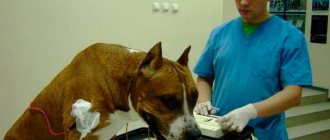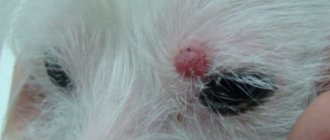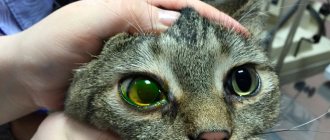What is it about
Another name for pododermatitis is interdigital pyoderma; easily excitable dogs with “fine mental organization”, dachshunds, sharpeis, bulldogs, Great Danes, and boxers are prone to it. Pododermatitis is often diagnosed in Labrador retrievers as a result of compulsive licking between the toes of the front paws.
The inflammatory process affects places on the paws that are in more contact with the ground (snow, asphalt) - the pads. Redder spots appear on them and between the fingers, which gradually grow in width, covering areas of healthy skin.
In dogs living in the city, cases of pododermatitis increase in winter due to contact with snow sprinkled with reagents.
A weakened immune system provokes the development of opportunistic microflora that is constantly present on the skin (Malassezia), but for most of the dog’s life it is in “sleeping mode.”
Why are my dog's toes swollen?
There may be several reasons for swollen toes on dog paws, but more often than not, the root cause of this condition is a minor injury or the entry of a foreign body, with the addition of an infection. Also, one should not exclude the possibility of a more serious fracture, dislocation and ingrown nail, although sometimes cancerous tumors require surgical intervention. In order not to make a mistake in the diagnosis, it is important to know about the main symptoms of each problem.
Injury
The most common minor injuries to dogs' toes include:
- cut by glass or other sharp object (mainly while walking);
- bruise as a result of an unsuccessful jump (swelling appears approximately 1-2 hours after the injury);
- insect or snake bite (if an animal has been bitten by a poisonous snake, you should not hesitate to visit a doctor);
- postoperative period (swelling is a natural reaction of living tissues to surgery, up to 14 days).
If the swelling does not go away within a few days, it is quite possible that the drainage of fluids in the tissues is impaired and the finger is swollen not only because of a minor scratch or cut. In such cases, surgical intervention is often required, but before this, the owner must independently examine the pet’s paw; it may be possible to detect a cut or bite mark (usually represented as a dot).
Did you know? If your dog's paws are not washed after walks, over time, microbes begin to multiply between the toes, resulting in a persistent smell of corn chips.
Entry of a foreign body or infection
The term “foreign body” in this case usually refers to splinters and thorns that get under the skin of a dog’s fingers while walking on the street. In some cases, you can notice and remove them by visual inspection of the paw, in others you will have to take the dog to the clinic and open the abscess surgically. Confirmation of the presence of a small splinter in the toes can be redness and an increase in temperature in a specific area of the skin, but if an infection is added to the damage, then the edema and swelling become much greater, often affecting not only the toe, but the entire paw.
Among the most common harmful microorganisms in this case are the following bacteria:
- staphylococcus;
- Pseudomonas aeruginosa;
- streptococcus;
- blastomycosis;
- cryptococcosis.
Infection and further inflammation of the paw pads can occur both as a result of non-compliance with hygiene measures after walking outside, and after the dog’s contact with already infected relatives. If there is an open wound surface, bacteria multiply very quickly and cause inflammation in the limb.
Fracture
A toe fracture is not fatal, but a very unpleasant injury, which is characterized by lameness, tissue swelling at the site of bone or joint damage, pain (the dog does not allow you to touch the paw) and a local increase in temperature. When palpating the limb, a displacement of the bone or a thickening of the finger may be felt, when pressed, the animal begins to whine. Sometimes, instead of a fracture, a crack in the bone tissue is diagnosed, but it will not be possible to visually distinguish it from a closed fracture; only an x-ray will help. Fractures of the toes or the entire paw are often typical for small breed dogs, which may well be injured simply by jumping off a sofa or chair.
Important! Until the limb is restored, it is very important to reduce the load on the sore paw as much as possible, limiting the dog’s mobility for the period of examination and treatment.
Dislocation
Dislocation of the limbs (including the dog’s fingers) is the displacement of the joints relative to each other, without violating the integrity of the bone ligament. Quite often, dislocations are accompanied by damage to the soft tissue structures of the joint, with rupture of blood vessels, joint ligaments, its capsule, and tendons of adjacent muscles. Outwardly, all this manifests itself in the lameness of the animal, and upon careful examination, swelling and deformation of the contours of the damaged joint are diagnosed (especially noticeable when comparing the area with a similar place on the second, healthy paw).
If you suspect a dislocation, never try to straighten it yourself, because this will not only cause the dog terrible pain, but can also provoke the development of an inflammatory process due to incorrectly performed actions. Before visiting a doctor, it is important to try to immobilize the animal’s injured limb and apply a cold compress to it.
Ingrown nail
This problem is more common in domestic dogs that have no place to trim their nails naturally. In most cases, the ingrowth of the claw is observed from the side of the fifth toe, which, as it grows, begins to round and cuts into the pad, forming a wound surface. Already at the initial stages, the animal cannot move normally, because the affected paw is very painful and swollen.
Read more about treating luxating patella in dogs.
In the absence of medical attention, inflammation can spread from one toe to another, causing even more discomfort to the pet. If the claw has not grown much and has only partially touched the skin, the owner can cut it off himself, having previously treated the surface of the paw with any antiseptic composition. In more advanced cases, especially if pus has accumulated under the skin, you will have to seek veterinary help.
Cancerous tumors
Unfortunately, finger tumors are not a rare problem in pets, and they are much more common in dogs than in cats. On average, approximately 61% of neoplasms are malignant, 20% are benign, and 19% are pyogranulomatous inflammation. About 12% of the total number of inflammations of the claws and nail bed are classified as tumors.
The most effective diagnostic method in this case will be an x-ray examination of the limb, since osteolysis, that is, melting of the bone, is clearly visible in the image, which in 83% of cases is considered to confirm the presence of a malignant neoplasm. Among benign tumors, intraosseous epidermal cysts and infiltrating lipomas lead to the same symptoms. Neoplasms on the paws can affect one toe (for example, soft tissue sarcoma or osteosarcoma) or spread to the tarsus, affecting the dog's wrists (synovial sarcoma and adenocarcinoma). In each of these cases, surgery and further long-term treatment cannot be avoided.
Important! The average age of dogs with tumors on their toes is 9 years, and 75% of them are large animals.
Causes
If the skin is affected only in a few places, the disease proceeds well and even treatment at home is possible.
List of typical reasons:
- Injuries. There are many factors that can lead to damage - stone impact, high or low temperatures, etc.
- Foreign bodies. The seeds of some types of herbs penetrate the surface layers of the skin, causing an inflammatory process. Thorns and wood chips are also dangerous.
- Tumors. In dogs after 5-6 years of age, pododermatitis develops due to the development of tumor-like processes, in particular squamous cell carcinoma, plasmacytoma, etc.
Extensive and severe lesions with bacterial pododermatitis in dogs can develop against the background of other diseases:
- Hookworms, ticks, fleas, lice eaters.
- Dermatophytosis or fungus.
- Food allergy, the body's reaction to one or more components in the diet.
- Pathologies of the endocrine system. More often, symptoms of pododermatitis accompany low levels of thyroid hormones, Cushing's syndrome, or excess production of adrenal hormones.
- Malfunctions of the immune system.
General information
What is furunculosis?
Furunculosis is a disease of bacterial origin and is characterized by the appearance of ulcers of the sebaceous glands and inflammation of the dog’s hair follicle. Mostly, dogs with poor immunity become infected with furunculosis through contact with a sick person. Boils begin to appear on the dog’s body and bother him. This disease is quite common in dogs.
What is a boil?
The boil itself looks like a dense cone-shaped swelling. Dogs react very painfully to its appearance. Once the boil occurs, it begins to develop and grow, eventually maturing and reaching the size of a ruble coin. When a yellowish spot appears on the surface of the boil, its core is formed, at the base of which is a hair. At this stage of development, the boil may open on its own, which is extremely undesirable, because then the resulting pus will come to the surface of the skin, infection will occur and new boils will appear.
Causes of boils in dogs
The main cause of furunculosis is staphylococcus. In addition, reasons may include:
- — the dog’s state of stress (for example, moving or changing owner);
- - lack of vitamins in the body;
- - low hemoglobin, against which a loss of strength may occur;
- - dirty skin;
- - sores, abrasions on the dog’s skin;
- - indigestion.
Symptoms of furunculosis
During the disease with furunculosis, the following symptoms appear:
- - swelling, dense to the touch and externally reddish in color;
- - a small knot at the base of the dog's hair;
- - the dog displays aggression or pain when in contact with the sore;
- - over time, a yellowish spot appears on the sore;
- - After some time, the boil matures and opens on its own.
Characteristic symptoms
Signs of pododermatitis most often appear on the front legs.
What you can see:
- severe redness of the skin;
- formation of pustules;
- formation of nodules.
Nodules, blisters, fistulas, bald spots and areas of skin with severe swelling are visually visible. Often the paws become itchy, which causes the dog to constantly lick them and further intensify the symptoms.
With a strong inflammatory process, lameness and enlargement of nearby lymph nodes may appear.
How to recognize the disease
An abscess in a dog, the photo of which is presented in this article, can be determined visually if the symptoms are severe, but in some cases it cannot be done without special examinations. Symptoms differ for different inflammatory processes.
Symptoms of a benign abscess:
- swelling with clear edges;
- redness;
- pain when touched.
Symptoms of malignancy:
- formation of a soft tubercle;
- increased body temperature of the animal;
- severe pain when pressed.
An abscess of a dog’s paraanal glands not only gives external symptoms, but also affects the general condition of the pet’s body. Observed:
- lethargy;
- gloominess;
- increased body temperature;
- lack of appetite;
- apathy and indifference to walks;
- the anal area becomes inflamed;
- purulent ulcers form;
- there is pain in the adjacent tissues.
You should not try to clean the wound yourself, so as not to harm the animal. You should immediately contact a specialist.
If the symptoms do not indicate a specific type of abscess, and the pet’s condition worsens, then you should immediately contact the veterinary clinic. Timely diagnosis and proper treatment will help avoid complications.
Diagnostics
In order for the treatment of pododermatitis to be as successful as possible, it is necessary to accurately confirm the diagnosis. To do this, a cytological examination of the purulent focus is carried out. With pododermatitis, staphylo- and/or streptococci and bacilli are found in smears.
When examining tissues, areas of pus, boils, and follicles are found.
If a dog is suspected of having pododermatitis, it is examined and diseases similar in clinical picture are excluded:
- Maassesial (yeast fungus) dermatitis.
- Demodecosis.
- Actinomycosis.
- Mycobacteriosis.
Tumor processes and autoimmune diseases must be excluded; each pathology on the list has symptoms similar to pododermatitis, but they must be treated differently.
Symptoms
Cysts in dogs on the back, on the stomach and even between the fingers have the same symptoms:
- they slowly and gradually increase in size;
- do not cause pain (i.e., the tumor itself does not cause trouble for the dog);
- when you touch the cyst, the growth appears heterogeneous, but the bubble itself is smooth to the touch;
- this disease causes fatigue in the dog, it quickly becomes exhausted and sleeps longer than usual;
- in rare cases, body temperature may increase;
- The dog loses its appetite and quickly loses weight.
There are also internal types of cysts. They do not appear externally in any way, and you can understand that a dog has an internal cyst when the dog:
- has a high temperature;
- loses appetite;
- weakens and often sleeps at home.
This disease is much more dangerous than, for example, a cyst on the paw. Because the symptoms cannot be determined, and the bubble can burst at any moment. But there are symptoms after which the disease can be identified:
- nausea, involuntary vomiting;
- bleeding begins;
- Unlike external growths, an internal cyst can cause severe pain to your dog.
There are also additional means of diagnosing cysts and these include: x-rays, ultrasound, as well as laboratory tests of urine and blood.
Treatment Basics
The entire treatment process is based on the cause that provoked the symptoms of pododermatitis. Treatment at home is not prohibited, but the dog must be under constant supervision.
Prescriptions of drugs are made by a veterinarian; using ointments, injections or antibacterial agents on your own is not recommended; an incorrectly used treatment regimen will, at best, not bring results. At worst, it will worsen symptoms.
In the presence of bacterial inflammation, local and systemic antibiotics are prescribed. It is important not to stop the course at the first signs of improvement, otherwise the “smothered” bacteria will rear their head again and the disease will return.
Treatment of swollen toes in dogs
The choice of drugs to eliminate swollen toes on pets directly depends on the root cause of the appearance of such a symptom. In many cases, local antiseptic compounds and antibiotics are prescribed, and for fractures, a plaster cast may be applied. For tumors, surgery is often prescribed to remove the tumor, and if the histology results confirm the malignancy of the tumor, you will have to undergo a course of additional chemotherapy.
Arthritis, especially purulent arthritis, is also often eliminated surgically, by opening the bursa and removing the pus. Unfortunately, it is not possible to completely cure arthritis, but swelling in the purulent form can be removed by relieving the pain with medications and massage. Without treatment, the disease becomes chronic and can cause deformation of the limbs.
Among the popular medications for the treatment of finger swelling of various etiologies, the following are most often used:
- anti-inflammatory and restorative medications with the possibility of simultaneous pain relief (for example, Bonharen, which in difficult cases can be prescribed together with erythromycin, amoxicillin and other antimicrobial drugs, if in addition to a bruise, an infection has also been diagnosed);
- warming compresses, possibly alcohol-based;
- local and general painkillers (for example, the non-steroidal anti-inflammatory drug Trocoxil or Isoflurane, relevant for fractures or other causes of severe pain);
- antitumor drugs, such as Cisplatin or Doxorubicin, which, after removing the malignant neoplasm, prolong the life of the dog.
Only a doctor can tell the exact purpose and dosage of a particular drug, having previously studied the complexity of the case. Self-medication is strictly not recommended, because even incorrect removal of a foreign object from a swollen finger with rotting can lead to even greater inflammation and a deterioration in the pet’s general well-being.
Did you know? Dogs' hearing is much sharper than humans'. For this reason, animals do not like the noise of falling rain and prefer to stay indoors in rainy weather.
How to treat the disease
Treatment of the disease is carried out using different methods. The veterinarian should prescribe a course of general and local therapy or recommend surgery.
If a benign abscess is diagnosed in a dog, treatment is carried out with medication, which consists of:
- absorbable ointments used to treat unruptured formations;
- antiseptic solutions for treating wounds in spontaneous cases;
- antiseptic ointments that are applied to the wound channels.
The affected area should be washed with a syringe so as not to cause unnecessary inconvenience to the pet.
When a malignant abscess is diagnosed, surgery is prescribed to remove the purulent sac. Manipulation should be carried out as quickly as possible, before the disease spreads to adjacent tissues. In the postoperative period, general and local therapy and a course of antibiotics are carried out.
If the paraanal glands are affected, treatment should be carried out in a clinical setting. After examination and determination of the extent of the problem, drug treatment in combination with warm compresses will be prescribed. In more serious cases, the veterinarian will open and treat the abscess himself. Often, additional drainage is required to remove pus. Afterwards, treatment with strong antibiotics is prescribed to suppress pathogenic microflora, using rectal suppositories and local treatments.
Stages and forms of occurrence
Under favorable conditions, conditionally pathogenic staphylococci that have penetrated into damaged tissues begin to actively develop. The inflammatory process involves the sebaceous gland located next to the hair follicle, as well as neighboring dermal tissues. The purulent process occurs in the following stages:
- Infiltration (initial). During this phase, swelling and redness of the skin are observed. The waste products of white and aureus staphylococci cause irritation of nerve endings, which is accompanied by pain in the inflamed area upon palpation.
As a rule, this stage of boil development remains unnoticed by the owner of a furry pet due to the thick fur. The dog may become restless and try to scratch the affected area.
- Suppuration phase. The inflammatory process progresses, the body's defense system actively fights the infection through phagocytosis. Blood flow increases in the surrounding tissues, and severe redness is observed. The body's fight against invading microbes leads to the formation of pus in the area of inflammation. When the boil is localized on a limb, the dog begins to limp.
An abscess under the armpits, on the inside of the thigh leads to the pet’s reluctance to run due to painful sensations. During this phase, the formation of a necrotic core occurs. The animal often experiences a rise in body temperature, lethargy, apathy, and refusal to feed. Surgical removal of the boil at this stage prevents its spontaneous opening and the spread of purulent infection to healthy tissue.
- Self-dissection. During this phase, the purulent contents melt and come out. According to veterinary experts, independent cleansing of the skin from purulent contents leads to an expansion of the infection zone and is extremely undesirable for animals with a weakened immune system.
- Healing. After the purulent masses are rejected, the wound surface begins to heal. Redness and swelling in the affected area decreases. The source of inflammation becomes covered with a crust, after which, when rejected, a scar or a bluish stain may remain in place of the boil.











